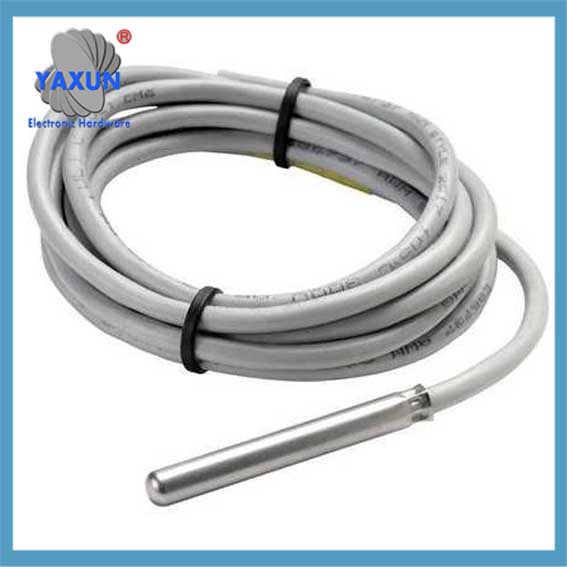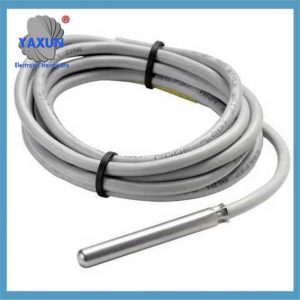หมวดหมู่สินค้า
- เบรกเกอร์ความร้อน 20
- ที่ยึดกล่องฟิวส์ 36
- เซ็นเซอร์อุณหภูมิ 67
- สวิตช์ความร้อน 64
- ฟิวส์รถยนต์ 19
- สลักเกลียวลงฟิวส์ 7
- ฟิวส์ความร้อน 32
- ฟิวส์ยึดพื้นผิว 12
- เทอร์มิสเตอร์ 22
- ตัวยึดฟิวส์ PCB Mount 27
- ชุดสายไฟ 6
- ตัวยึดฟิวส์ใบมีด 17
- เทอร์โมสตัท 46
- ฟิวส์ไฟฟ้า 14
แท็กสินค้า
กทช, พีทีซี, พีที100, DS18B20 สำหรับเซนเซอร์วัดอุณหภูมิ
หัววัดเทอร์โมคัปเปิล: ใช้เทอร์โมอิเล็กทริกในการวัดอุณหภูมิ, และมีลักษณะของช่วงการวัดที่กว้างและความเร็วในการตอบสนองที่รวดเร็ว.
หัววัดความต้านทานความร้อน: ใช้คุณสมบัติที่ความต้านทานของโลหะหรือวัสดุเซมิคอนดักเตอร์เปลี่ยนแปลงไปตามอุณหภูมิในการวัดอุณหภูมิ, และมีลักษณะของความแม่นยำในการวัดสูงและมีเสถียรภาพที่ดี.
โพรบเซมิคอนดักเตอร์: ใช้คุณสมบัติที่ค่าการนำไฟฟ้าของวัสดุเซมิคอนดักเตอร์เปลี่ยนแปลงตามอุณหภูมิในการวัดอุณหภูมิ, และมีลักษณะมีขนาดเล็ก, น้ำหนักเบาและใช้พลังงานต่ำ.
กทช, พีทีซี, พีที100, DS18B20 หัววัดอุณหภูมิและเซนเซอร์วัดอุณหภูมิมีบทบาทสำคัญในด้านการวัดอุณหภูมิ. ต่อไปนี้เป็นคำแนะนำโดยละเอียดเกี่ยวกับเซ็นเซอร์หัววัดอุณหภูมิ:
เซนเซอร์วัดอุณหภูมิมีหลายประเภท, รวมทั้ง:
เทอร์โมคัปเปิล
เซ็นเซอร์เหล่านี้ทำจากโลหะสองชนิดที่ไม่เหมือนกันซึ่งเชื่อมต่อกันที่จุดสองจุดเพื่อสร้างจุดเชื่อมต่อ. พวกเขาเชื่อถือได้, แม่นยำ, และสามารถทำงานได้ในช่วงอุณหภูมิที่หลากหลาย.
เครื่องตรวจจับอุณหภูมิความต้านทาน (RTD)
เซ็นเซอร์เหล่านี้อิงตามการเปลี่ยนแปลงความต้านทานของโลหะเมื่ออุณหภูมิเปลี่ยนแปลง.
เทอร์มิสเตอร์
เซ็นเซอร์เหล่านี้ใช้คุณลักษณะอุณหภูมิของตัวต้านทานเซมิคอนดักเตอร์, ซึ่งเปลี่ยนความต้านทานเมื่ออุณหภูมิเปลี่ยนแปลง. เทอร์มิสเตอร์มีความละเอียดอ่อนและมีความแม่นยำสูงเมื่อเทียบกับต้นทุน.
ค่าสัมประสิทธิ์อุณหภูมิติดลบ (กทช) เทอร์มิสเตอร์
เซ็นเซอร์เหล่านี้มีความไวและสามารถตอบสนองต่อการเปลี่ยนแปลงอุณหภูมิเพียงเล็กน้อยได้. พวกเขามีช่วงอุณหภูมิที่ -50 °C ถึง 250 องศาเซลเซียส.
เครื่องตรวจจับอุณหภูมิแบบต้านทาน
เซ็นเซอร์เหล่านี้มีค่าสัมประสิทธิ์อุณหภูมิที่เป็นบวก (พีทีซี) และมีการวัดอุณหภูมิที่แม่นยำ. อย่างไรก็ตาม, พวกเขามีความไวต่ำ.
1. ความหมายและหลักการทำงาน
หัววัดอุณหภูมิ:
คำนิยาม: หัววัดอุณหภูมิเป็นอุปกรณ์ที่ใช้วัดอุณหภูมิโดยเฉพาะ, และส่วนประกอบหลักของมันคือองค์ประกอบที่ไวต่ออุณหภูมิ.
หลักการทำงาน: หัววัดอุณหภูมิใช้องค์ประกอบที่ละเอียดอ่อน (เช่น เทอร์โมคัปเปิ้ล, ตัวต้านทานความร้อน, เซมิคอนดักเตอร์, ฯลฯ) เพื่อแปลงการเปลี่ยนแปลงของอุณหภูมิเป็นสัญญาณไฟฟ้าสำหรับการประมวลผลวงจรหรือการแสดงผลในภายหลัง.
เซ็นเซอร์อุณหภูมิ:
คำนิยาม: เซ็นเซอร์วัดอุณหภูมิเป็นแนวคิดที่กว้างขึ้นซึ่งรวมถึงหัววัดอุณหภูมิและวงจรประมวลผลสัญญาณที่เชื่อมต่ออยู่ด้วย.
หลักการทำงาน: เซ็นเซอร์วัดอุณหภูมิไม่เพียงแต่มีองค์ประกอบที่ละเอียดอ่อนเท่านั้น, แต่ยังมีวงจรประมวลผลสัญญาณที่สามารถรับสัญญาณได้ครบถ้วน, การประมวลผลและเอาท์พุตของสัญญาณอุณหภูมิ, มักจะอยู่ในรูปแบบของสัญญาณดิจิทัลหรือแอนะล็อก.
2. ประเภทและลักษณะ
ประเภทหัววัดอุณหภูมิ:
หัววัดเทอร์โมคัปเปิล: ใช้เทอร์โมอิเล็กทริกในการวัดอุณหภูมิ, และมีลักษณะของช่วงการวัดที่กว้างและความเร็วในการตอบสนองที่รวดเร็ว.
หัววัดความต้านทานความร้อน: ใช้คุณสมบัติที่ความต้านทานของโลหะหรือวัสดุเซมิคอนดักเตอร์เปลี่ยนแปลงไปตามอุณหภูมิในการวัดอุณหภูมิ, และมีลักษณะของความแม่นยำในการวัดสูงและมีเสถียรภาพที่ดี.
โพรบเซมิคอนดักเตอร์: ใช้คุณสมบัติที่ค่าการนำไฟฟ้าของวัสดุเซมิคอนดักเตอร์เปลี่ยนแปลงตามอุณหภูมิในการวัดอุณหภูมิ, และมีลักษณะมีขนาดเล็ก, น้ำหนักเบาและใช้พลังงานต่ำ.
ประเภทเซ็นเซอร์อุณหภูมิ:
เซ็นเซอร์อุณหภูมิแบบอะนาล็อก: ส่งสัญญาณอนาล็อก, ซึ่งจำเป็นต้องแปลงเป็นสัญญาณดิจิทัลด้วยตัวแปลงแอนะล็อกเป็นดิจิทัลเพื่อการประมวลผลในภายหลัง.
เซ็นเซอร์อุณหภูมิแบบดิจิตอล: ส่งสัญญาณดิจิตอลออกมาโดยตรง, มีความสามารถในการป้องกันการรบกวนที่แข็งแกร่ง, ความแม่นยำสูง, และง่ายต่อการรวมเข้ากับระบบควบคุม.
เซ็นเซอร์อุณหภูมิอัจฉริยะ: มีการวินิจฉัยตนเอง, การสอบเทียบด้วยตนเอง, การสื่อสารและฟังก์ชั่นอื่น ๆ, และสามารถตรวจสอบและควบคุมระยะไกลได้.
3. การคัดเลือกและการประยุกต์ใช้
ปัจจัยการคัดเลือก:
สภาพแวดล้อมการใช้งาน: พิจารณาว่าสภาพแวดล้อมที่ตรวจวัดมีสภาวะพิเศษ เช่น การกัดกร่อน หรือไม่, อุณหภูมิสูง, แรงดันสูง, ฯลฯ, เพื่อเลือกวัสดุและระดับการป้องกันที่เหมาะสม.
ช่วงการวัด: เลือกเซ็นเซอร์ที่เหมาะสมตามช่วงอุณหภูมิที่จะวัดเพื่อให้แน่ใจว่าเซ็นเซอร์สามารถวัดได้อย่างแม่นยำภายในช่วงที่ต้องการ.
ข้อกำหนดด้านความแม่นยำ: ตามความต้องการความแม่นยำของการประยุกต์ใช้ในการวัดอุณหภูมิ, เลือกเซ็นเซอร์ที่มีความแม่นยำสอดคล้องกัน.
งบประมาณต้นทุน: ภายใต้หลักประกันประสิทธิภาพการทำงาน, พิจารณาปัจจัยด้านต้นทุนและเลือกเซ็นเซอร์ที่คุ้มค่า.
พื้นที่การใช้งาน:
ระบบอัตโนมัติทางอุตสาหกรรม: ใช้ในการติดตามการเปลี่ยนแปลงอุณหภูมิในอุปกรณ์อุตสาหกรรม, เครื่องจักรและกระบวนการผลิตเพื่อให้มั่นใจว่าอุปกรณ์และคุณภาพของผลิตภัณฑ์ทำงานได้ตามปกติ.
อุตสาหกรรมการแพทย์: ใช้ในอุปกรณ์ทางการแพทย์, เครื่องมือตรวจวัดอุณหภูมิและอุปกรณ์จัดเก็บยาเพื่อตรวจวัดอุณหภูมิคนไข้, อุณหภูมิโดยรอบและสภาวะการเก็บรักษายา.
อุตสาหกรรมยานยนต์: ใช้ในมอเตอร์ไฟฟ้า, ตัวเก็บประจุ, ตัวแปลงไฟกระแสตรง, ระบบชาร์จ, เช่นเดียวกับเครื่องยนต์ของรถยนต์, กระปุกเกียร์, ระบบปรับอากาศและระบบไอเสียเพื่อตรวจสอบและควบคุมอุณหภูมิของของเหลวและก๊าซต่างๆ.
เกษตรกรรมและอุตสาหกรรมแปรรูปอาหาร: ใช้ในโรงเรือนเกษตร, ห้องเย็น, อุปกรณ์แปรรูปอาหารและยานพาหนะขนส่งเพื่อตรวจสอบและควบคุมอุณหภูมิสินค้าเกษตรและอาหาร.
สาขาอื่นๆ: เช่นอุตสาหกรรมเครื่องปรับอากาศและเครื่องทำความเย็น, อุตสาหกรรมการทหารและการบินและอวกาศ, อุตสาหกรรมอินเทอร์เน็ตของสรรพสิ่ง, ฯลฯ. ยังใช้กันอย่างแพร่หลาย.
IV. การใช้และการบำรุงรักษา
การติดตั้ง: ติดตั้งเซ็นเซอร์อย่างถูกต้องตามคำแนะนำในการติดตั้งเพื่อให้แน่ใจว่ามีการสัมผัสที่ดีระหว่างเซ็นเซอร์กับวัตถุที่จะวัด และหลีกเลี่ยงข้อผิดพลาดในการวัดที่เกิดจากการติดตั้งที่ไม่เหมาะสม.
การเดินสายไฟ: เชื่อมต่อสายสัญญาณและสายไฟของเซ็นเซอร์อย่างถูกต้องเพื่อให้มั่นใจในความเสถียรและความแม่นยำของการส่งสัญญาณ.
การสอบเทียบ: ปรับเทียบเซ็นเซอร์เป็นประจำเพื่อให้แน่ใจว่าความแม่นยำในการวัดตรงตามข้อกำหนดการใช้งาน. กระบวนการสอบเทียบมักจะเกี่ยวข้องกับการวางเซ็นเซอร์ไว้ในสภาพแวดล้อมที่มีอุณหภูมิที่ทราบ, เปรียบเทียบความแตกต่างระหว่างค่าเอาท์พุตกับค่ามาตรฐาน, และทำการปรับเปลี่ยนที่จำเป็น.
การซ่อมบำรุง: ทำความสะอาดและบำรุงรักษาเซ็นเซอร์เป็นประจำเพื่อหลีกเลี่ยงฝุ่น, สิ่งสกปรก, ฯลฯ. ที่ส่งผลต่อประสิทธิภาพการวัดของเซนเซอร์. ในเวลาเดียวกัน, ให้ความสนใจในการตรวจสอบว่าการเชื่อมต่อสายเคเบิลหลวมหรือเสียหายหรือไม่, และเปลี่ยนชิ้นส่วนที่เสียหายให้ทันเวลา.
โดยสรุป, เซ็นเซอร์วัดอุณหภูมิมีการใช้งานที่หลากหลายและเป็นตำแหน่งที่สำคัญในด้านการวัดอุณหภูมิ. เมื่อเลือกและใช้งานแล้ว, จำเป็นต้องพิจารณาอย่างครอบคลุมตามสถานการณ์การใช้งานเฉพาะและข้อกำหนด เพื่อให้มั่นใจถึงความถูกต้องและความน่าเชื่อถือของผลการวัด. หากคุณมีคำถามอื่นๆ หรือต้องการความช่วยเหลือเพิ่มเติม, โปรดแจ้งให้เราทราบ.
ติดต่อเรา
กำลังรออีเมลของคุณ, เราจะตอบกลับคุณภายใน 12 ชั่วโมงด้วยข้อมูลอันมีค่าที่คุณต้องการ.
 English
English العربية
العربية Български
Български 粤语
粤语 中文(简体)
中文(简体) 中文(漢字)
中文(漢字) Nederlands
Nederlands Suomi
Suomi Français
Français Deutsch
Deutsch Ελληνικά
Ελληνικά Magyar
Magyar Italiano
Italiano 日本語
日本語 한국어
한국어 Polski
Polski Português
Português Română
Română Русский
Русский Slovenščina
Slovenščina Español
Español Svenska
Svenska ภาษาไทย
ภาษาไทย Türkçe
Türkçe Tiếng Việt
Tiếng Việt












